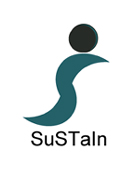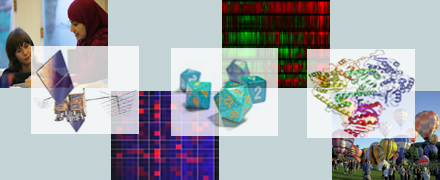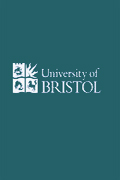 |
 |
 |
|
SuSTaIn
Events
Statworks workshop
Slides (password protected)
Invited speakers
Location
Programme
Abstracts (pdf)
Information for presenters
Participation
Accommodation
Conference dinner
Local Restaurants
Directions
|

ProgrammeAs researchers find networks a natural perspective for analysing a more and more diverse set of applications, an almost equally diverse set of a methodologies emerge, ranging from highly-tailored ad hoc solutions to broad attempts to capture the full generality of network inference. In such a new field of exploration, each of these disparate paths contributes to our joint understanding of the scope of network-based models. By gathering together statisticians, mathematical modellers and application-oriented researchers, we hope to further this progress by:
While the connections that might be made are impossible to foresee, we particularly seek to contribute by bringing together many of the most general modelling approaches, in order to inform other researchers about the state of rigorous inference. Conversely, we hope the probing of applications-oriented researchers of these statistical methods will point the way forward to improvements in practical theory. The topics covered by this conference include - but are not limited to: Methodology
Applications
The programme shown here is provisional, and correct as at 10 June 2010, also available here in pdf. Abstracts are available here in pdf. Monday 28 June08:30-09:20 Registration09:20-09:30 Opening remarks 09:30-10:30 Stanley Wasserman Statistical models for networks: The past, present, and future 10:30-11:00 Coffee Break 11:00-12:30 Statistics of networks 11:00-11:30 Ashley FORD (Warwick University) Statistically Equivalent Graphs and Product Space Representations 11:30-12:00 Nick FYSON (University of Bristol) Network Reconstruction by Set Covering 12:00-12:30 Arnold POLANSKI (Queen's University Belfast) Recovering Connection Structures from individual Attributes 12:30-13:30 Lunch 13:30-15:00 Epidemics 13:30-14:00 Xueying WANG (SAMSI) Pairwise Closure Approximations in epidemic models on networks 14:00-14:30 Theodore KYPRAIOS (university of Nottingham) Bayesian Inference for Stochastic Epidemic Models on Networks 14:30-15:00 Katy ROBINSON (University of Bristol) The dynamics of sexual contact networks: effects on disease spread and control 15:00-15:30 Coffee Break 15:30-16:30 Michael Stumpf 16:30-17:30 Eric Kolaczyk Drug Targets Prediction: Finding Biological Needles in a Haystack of Networks 18:00-20:00 Poster Session Tuesday 29 June09:00-10:00 Sanjeev Goyal Strategic Network Formation10:00-10:30 Coffee Break 10:30-12:00 Theory of networks 10:30-11:00 Nick JONES (Oxford Physics) A Taxonomy of Networks: Using a Mesoscopic response Function to investigate structure in empirical networks 11:00-11:30 Renaud LAMBIOTTE (Imperial College London) Dynamics, Modularity and Robustness of Complex Networks 11:30-12:00 Pierre-Olivier AMBLARD (CNRS/GIPSAlab) Directed information theory to infer causality graphs 12:00-13:00 Lunch 13:00-14:00 Stephane Robin Uncovering structure in biological interaction networks 14:00-15:00 Viewing the Goldney Grotto 15:00-15:30 Coffee Break 15:30-17:00 Social networks 15:30-16:00 Tyler McCORMICK (Columbia University) Latent Structure Models for Social Networks using Aggregated Relational Data 16:00-16:30 Tauhid R ZAMAN (Massachusetts Institute of Technology) Finding rumor Sources in Networks 16:30-17:00 Nick HEARD (Imperial College London) Bayesian Anomaly Detection Methods for Social Networks Wednesday 30 June09:00-10:00 Geoffrey West Universal Scaling Laws, Network Structures, Sustainability and the Pace of Life from Cells and Ecosystems to Cities and Corporations10:00-10:30 Coffee Break 10:30-12:00 Biological and genetic networks 10:30-11:00 Christopher PENFOLD (University of warwick) Systems Biology Networks 11:00-11:30 Mudassar IQBAL (University of warwick) An integrative Bayesian Analysis of Transcription regulation in S.coelicolor 11:30-12:00 Miguel JUAREZ (University of warwick) Inferring the topology of a non-linear gene regulatory network using fully Bayesian spline regression 12:00-13:00 Lunch 13:00-14:30 Statistics of networks 13:00-13:30 Clive BOWSHER (University of Cambridge) Biomolecular Networks: Dynamic Independence, Modularisation and Information Processing 13:30-14:00 Andrew SMITH (University of Bristol) Nonparametric regression on a graph 14:00-14:30 Patrick O. PERRY (Harvard University) A graph log-linear model for charaterizing repeated interactions 14:30-15:00 Coffee Break 15:00-16:00 Sean Meyn The value of Volatile Resources in Electricity Markets 16:00-17:30 Traffic and transport 16:00-16:30 Andrei BEJAN (University of Cambridge) Statistical Modelling and Analysis of Sparse Bus Probe Data in Urban Areas 16:30-17:00 Richard GIBBENS (University of Cambridge) An investigation of proportionally fair ramp metering 17:00-17:30 Michael GASTNER (Imperial College London) The complex network of global cargo ship movements 19:00-23:00 Conference Dinner Thursday 1 July09:30-10:30 Animal social networks09:30-10:00 Ana B. SENDOVA-FRANKS (University of West of England, Bristol) Emergency networking in ant colonies 10:00-10:30 Dick JAMES (University of Bath) Animal Social Networks 10:30-11:00 Coffee Break 11:00-12:00 David Barber Finding graph clusters using clique matrices 12:00-13:00 Brendan Murphy A mixture of experts latent position cluster model for social network data 13:00-14:00 Lunch 14:00 Conference ends |